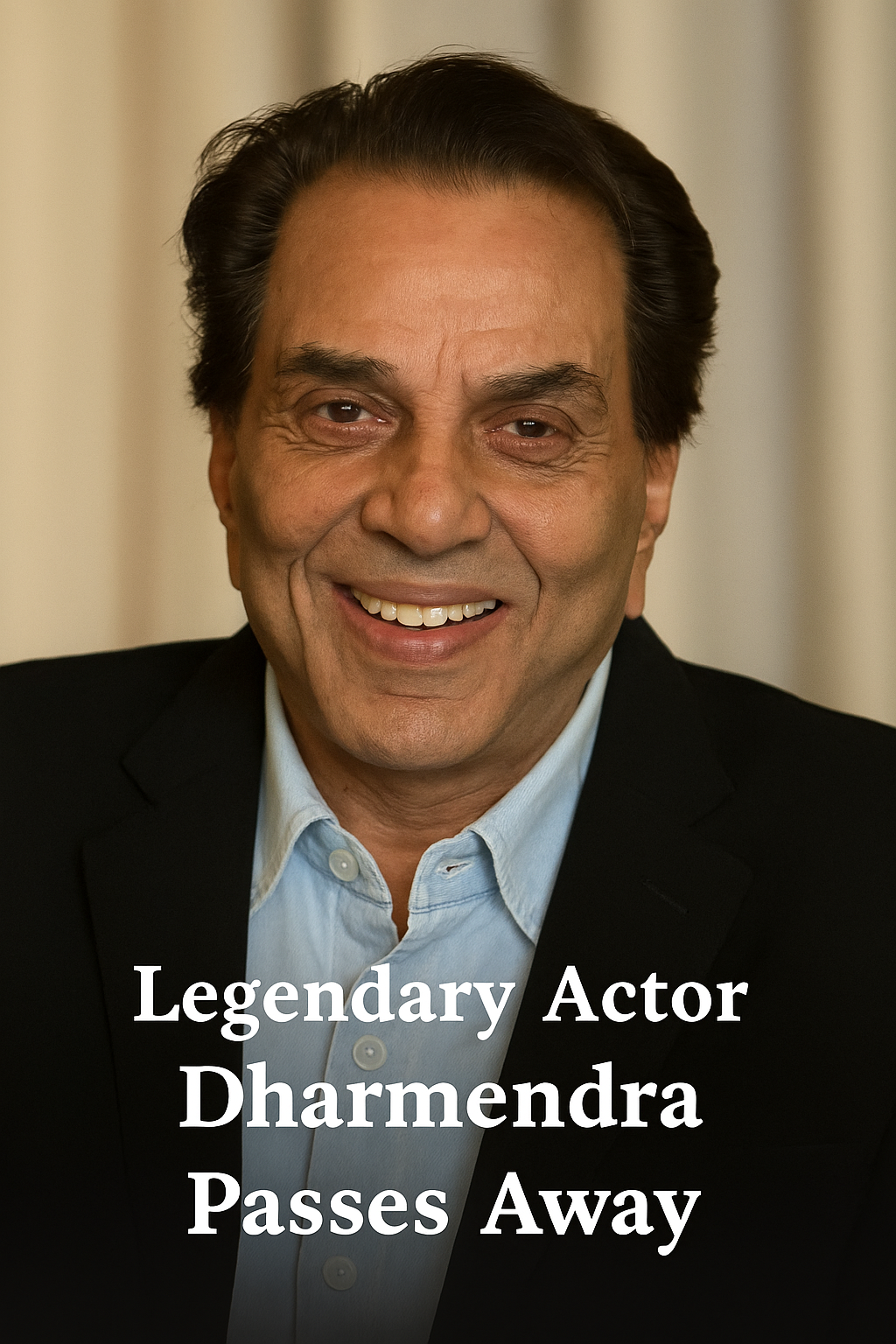Dharmendra, one of Indian cinema’s most adored and enduring actors, passed away in Mumbai at the age of 89. His death has left the film industry, his colleagues and millions of admirers with a sense of personal grief. For many, his face was woven into memories of growing up, weekend television, family movie nights and the golden years of Hindi cinema.
The actor had been discharged from Breach Candy Hospital earlier this month after a period of medical supervision. He was resting at home when his health declined. His sons Sunny and Bobby Deol, along with Hema Malini and close relatives, remained by his side during his final hours. His last rites were performed at the Pawan Hans crematorium, where the family gathered quietly as colleagues and friends arrived to pay tribute.
A Star Who Made Emotion Feel Real on Screen
Dharmendra’s stardom stood on something simple, something rare. He acted with honesty.
He entered scenes not as a performer trying to impress, but as a human being responding with sincerity. That quality defined his career across six decades and made him relatable to audiences of every age group.
His on-screen persona radiated warmth. He could play the fearless hero, the gentle lover, the protective friend and the conflicted man, all without losing the natural charm that became his signature.
His fans still quote the iconic line from Sholay:
“Basanti, in kutton ke samne mat nachna.”
Few dialogues in Indian cinema have travelled through generations with such affection.
In Chupke Chupke, his subtle humour and soft timing showed his versatility long before multi-genre acting became common. His portrayal of Satyapriya in Satyakam remains one of the most respected dramatic performances of the era.
The Films That Built His Legacy
Dharmendra’s filmography is one of the richest in Hindi cinema, with landmark roles across genres.
Sholay (1975)
A cultural milestone. His portrayal of Veeru blended courage, loyalty and humour, making him unforgettable.
Chupke Chupke (1975)
A masterclass in understated comedy. Critics often describe this as one of his most refined performances.
Satyakam (1969)
Directed by Hrishikesh Mukherjee, this remains Dharmendra’s most critically acclaimed role. Many filmmakers still cite this as a benchmark for emotional honesty.
Anupama (1966)
A gentle, lyrical film where his quiet performance added depth to an already delicate story.
Phool Aur Patthar (1966)
The film that established him as a leading man. His physicality and emotional intensity became defining traits.
Yaadon Ki Baaraat (1973)
A film that shaped the masala template for decades. His presence elevated every frame.
Songs That Continue to Carry His Warmth
Some of the most evergreen melodies in Hindi cinema were filmed on Dharmendra, and they still carry emotional resonance.
- “Pal Pal Dil Ke Paas” from Blackmail, one of Bollywood’s most remembered romantic songs
- “Main Jat Yamla Pagla Deewana” from Pratigya, which captured his playful side
- “Kya Hua Tera Wada”, which pulls listeners instantly back into the seventies
- “Zindagi Ek Safar Hai Suhana”, with Dharmendra’s presence in its iconic opening sequence
These songs are not just favourites. They are emotional markers that link people to their childhoods and families.
A Reputation Built on Kindness and Humility
Behind the camera, Dharmendra was known for humility.
Directors often recalled how he treated every member of a crew with respect. Younger actors described him as gentle, soft-spoken and approachable.
A senior filmmaker who worked with him shared,
“Dharmendra ji brought sincerity into every shot. He never overacted. He simply felt the moment.”
An actor from the younger generation once said,
“He made strength look human and romance look genuine. He shaped how the Hindi film hero should feel, not just how he should look.”
He insisted on performing many of his own stunts, especially in films like Dharam Veer and Phool Aur Patthar, which won him admiration for discipline and fearlessness.
A Family Bids Goodbye to a Pillar of Their World
The Deol family stood together as they performed the last rites.
Sunny Deol, emotionally moved, thanked those who came to honour his father. Bobby Deol remained close to his mother, Hema Malini, as the family received visitors who had known Dharmendra through the earliest days of his film journey.
Their grief reflects more than personal loss. It marks the departure of a man who shaped their lives both as a father and as a mentor.
Why His Passing Feels Like the End of an Era
Dharmendra represented a cinema that valued sentiment, softness and sincerity. He belonged to a time when storytelling was personal and emotional, when heroes showed strength without losing vulnerability.
His passing feels personal to many because his films were part of their lives. Families bonded over them. Children discovered them on television. Young adults returned to them for comfort. His presence created a sense of familiarity that few actors could match.
His legacy, however, remains fully alive.
Every time a line from Sholay is quoted, every time “Pal Pal Dil Ke Paas” plays at a family gathering, every time an actor speaks about sincerity in performance, Dharmendra’s influence continues to shape the culture.
Dharmendra leaves behind more than a body of work.
He leaves behind a feeling.
A feeling that belongs to a kinder era of Hindi cinema.
An era that continues to live through him.
FAQs
What were Dharmendra’s most iconic films?
Dharmendra is remembered for major classics such as Sholay, Chupke Chupke, Satyakam, Phool Aur Patthar, Anupama and Yaadon Ki Baaraat. These films shaped different phases of Hindi cinema and continue to be watched across generations.
Why is Dharmendra considered one of Hindi cinema’s most beloved actors?
He brought sincerity and natural warmth to every role. His performances felt relatable, emotional and grounded, making viewers connect with him in a personal way. His mix of strength and softness became his trademark.
Which songs filmed on Dharmendra remain evergreen?
Songs such as “Pal Pal Dil Ke Paas”, “Main Jat Yamla Pagla Deewana”, “Zindagi Ek Safar Hai Suhana” and “Kya Hua Tera Wada” continue to hold nostalgic and cultural value.
How did the film industry react to his passing?
Actors, directors and technicians across age groups expressed deep grief. Many described him as gentle, humble and deeply respected. Events scheduled for the day were postponed as a mark of respect.
Did Dharmendra perform his own stunts?
Yes. He was known for taking on challenging action scenes in films like Phool Aur Patthar and Dharam Veer, earning a reputation for discipline and physical courage.
What made Dharmendra’s acting style stand out?
He avoided theatrical exaggeration and focused on natural expression. His modesty, emotional depth and sense of sincerity distinguished him from many of his contemporaries.
How is Dharmendra’s legacy carried forward today?
His influence is reflected in the work of actors who grew up watching him, in the continued popularity of his films and songs, and through the Deol family’s presence in the industry.

